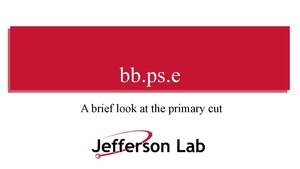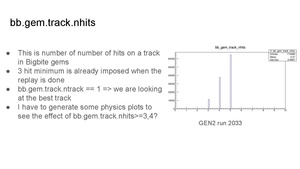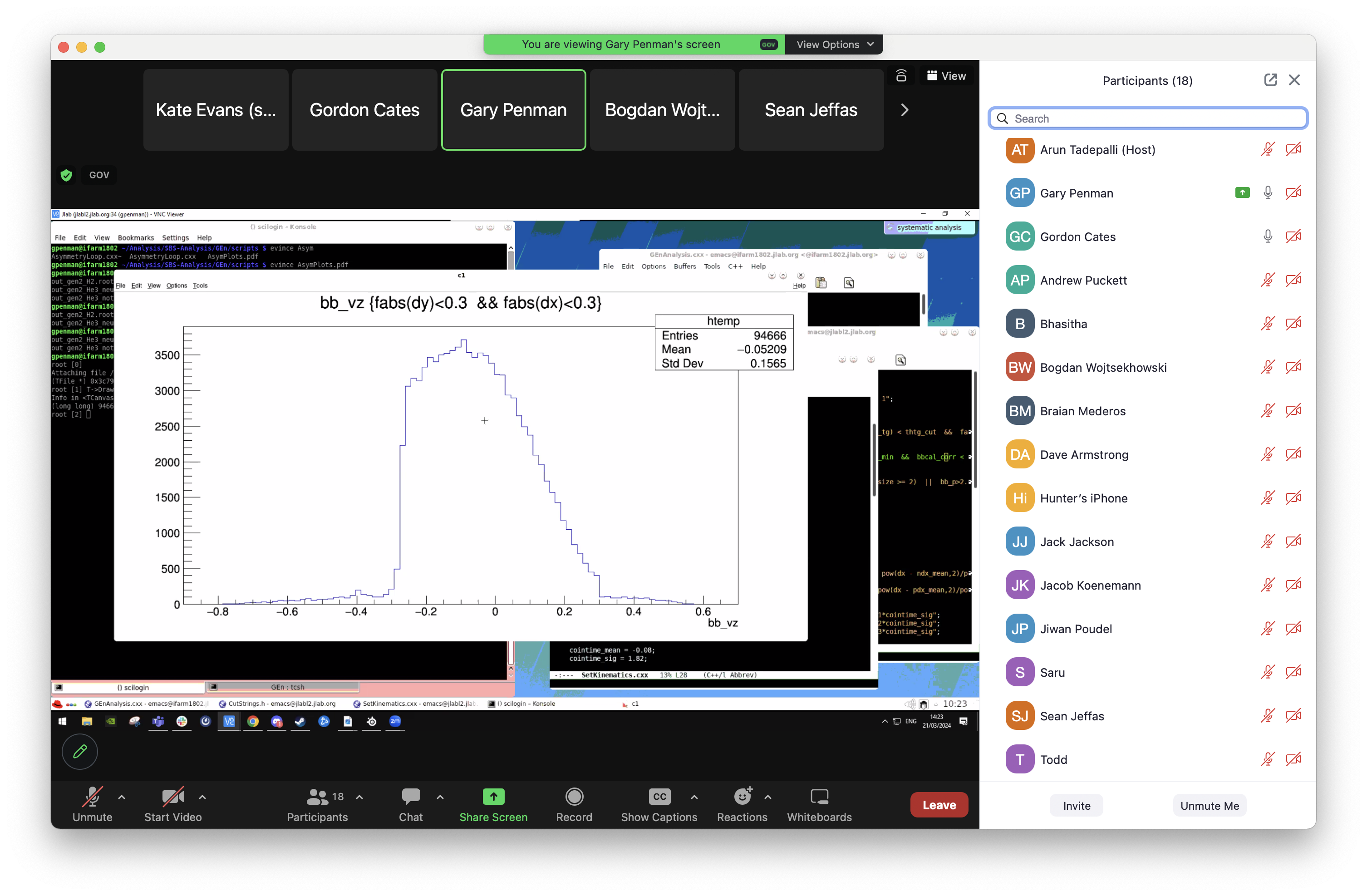GEn Analysis Meeting March 28 2024 10AM EST
From SBS wiki
Revision as of 10:01, 28 March 2024 by Jeffas (Talk | contribs) (Created page with "Back to SBS Main Wiki >> GEn Analysis Meetings >> following meeting >> GEn_Analy...")
Back to SBS Main Wiki >> GEn Analysis Meetings
Agenda
- Preshower energy cut-> Jack Jackson

- Target vertex cut -> Hunter Presley

- Number of hits per track cut -> Vimukthi Haththothuwa Gamage

- BBCal energy cuts -> Gary Penman [1]
- Proposed GEN asymmetry analysis procedure -> Bogdan Wojtsekhowski [2]
Attendance
Arun, Hunter, Gordon, Andrew, Braian, David, Gary, Jack, Jacob, Jiwan, Saru, Sean, Todd, Vimukthi, Vladimir, Bogdan, Kate, Don
Minutes
Jack's talk:
- It makes sense that at higher Q2, the pion peak dominates
- Better GEN4 BBCal calibrations will help clean up the peaks for this ps.e cut
- Do we have a sense for how many good events we're losing by making the cut tighter around the electron peak?
- Electron energy doesn't vary all that much between kinematics, so the way the electron peak looks in GEN2 tells us what it'll look like in GEN4
- Efficiency of electrons for a 0.2GeV is pretty good.
Hunter's talk:
- proposed 1-sigma cut on the mean of the peak for each window
- suggested absolute cut includes ~55cm of the 60cm target
- entire peak should ideally be gone, so maybe a 3-sigma fit would be better
- if you only look at quasi-elastics, you don't see these peaks:
- use the real world knowledge of the width of the target windows to help understand the smearing
- it might be good to use a window cut when we want to cut out background (get shape of background)
- aside from Bogdan: data from optics target gives empirical information about N2?
- this cut may not be needed in general if it is already taken care of by other cuts/calibrations
- later we can sanity check this cut value
Vimukthi's talk:
- bb.gem.track.ntrack == 1
- this might be too tight
- look at first track regardless of number of tracks found so that we don't artificially lower efficiency
- "first track" is a complicated topic that would take a long time to explain, but it is directly related to the quality of the track (straight line through GEMs, hitting calorimeters, etc)
- change to bb.gem.track.ntrack >= 1 - Andrew
- https://sbs.jlab.org/cgi-bin/DocDB/private/ShowDocument?docid=368 some documentation on GEM tracking
Gary's talk:
- H2 events don't populate a certain area so it makes sense that if bbcal calibrations are only based on those then it makes sense that these areas aren't well calibrated
- further bbcal calibrations using generic electrons instead of H2 data will help
Bogdan's talk:
- assume you know helicity, what does this event tell you about it
- not quite a measurement of helicity
- this is a slightly different method than original GEN formalism
- this should lead to the same results
- experiment is stable with time (not helicity correlated beam corrections)
- charge asymmetry? amount of beam in helicty left = helicity right? Should be true
- there are not totally trivial charge asymmetries that should be considered
- A_i depends on Q2 and each event has a separate Q2
- GM and GE are kinematic dependent
- event-by-event kinematic corrections is being done here
- dependence on Q2 is certainly not small
- great improvement to look at event-by-event instead of averaging over the entire experiment
- should chi-squared minimize to 1? no
- how is this chi-squared metric consistent?
- implement where the polarization of the beam is constant?
- steps in beam polarization add uncertainty
Think about Bogdan's method for discussion next week!
Meeting link information
See email invitation, or contact Arun Tadepalli for Zoom link.
